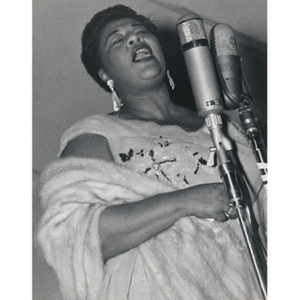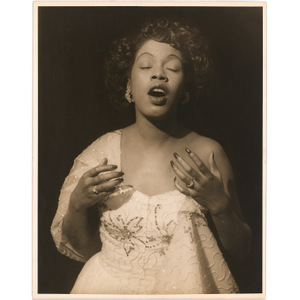Description
A consummate vocal artist, Sarah Vaughan moved effortlessly between the worlds of jazz and pop music. Following her debut with Earl Hines’s orchestra (1943), Vaughan joined Billy Eckstine’s pioneering band, where she was profoundly influenced by its stellar roster of jazz and bop innovators, including Charlie Parker and Dizzy Gillespie. She remained with Eckstine for a year and worked briefly with John Kirby’s ensemble before launching her highly successful solo career in 1946. The supple contralto and remarkable range showcased on Vaughan’s first hit, “Tenderly” (1947), won her legions of fans. Peers such as Ella Fitzgerald called her the world’s “greatest singing talent,” and the readers of DownBeat magazine voted her the best female singer for six consecutive years (1947–52). When Vaughan performed at Carnegie Hall in 1957, New York Times music critic John S. Wilson observed, “She has what may well be the finest voice ever applied to jazz.”La consumada vocalista Sarah Vaughan transitaba sin esfuerzo entre los mundos del jazz y la música pop. Después de debutar con la orquesta de Earl Hines (1943), Vaughan se incorporó a la novel banda de Billy Eckstine, donde recibió importantes influencias de aquel elenco estelar de pioneros del jazz y el bop como Charlie Parker y Dizzy Gillespie. Permaneció con Eckstine un año y trabajó brevemente con el conjunto de John Kirby antes de lanzarse a una exitosa carrera como solista en 1946. Su rica tesitura de contralto y su extraordinario registro, evidentes ya en su primer éxito, “Tenderly” (1947), le...
Image
Selenium Toned Gelatin Silver Print
National Portrait Gallery, Smithsonian Institution
Record Contributed By
National Portrait GalleryRecord Harvested From
Smithsonian InstitutionKeywords
- Bracelet
- Costume
- Design
- Dress Accessories
- Dress Accessory
- Entertainers
- Equipment
- Feather
- Female
- Interior
- Interior Decoration
- Jazz
- Jewelry
- Leonard, Herman
- Microphone
- Musician
- Musicians
- Performer
- Performing Arts
- Pianist
- Portrait
- Portraits
- Ring
- Sarah Vaughan
- Singer
- Sound Devices
- Vaughan, Sarah
- Women





















